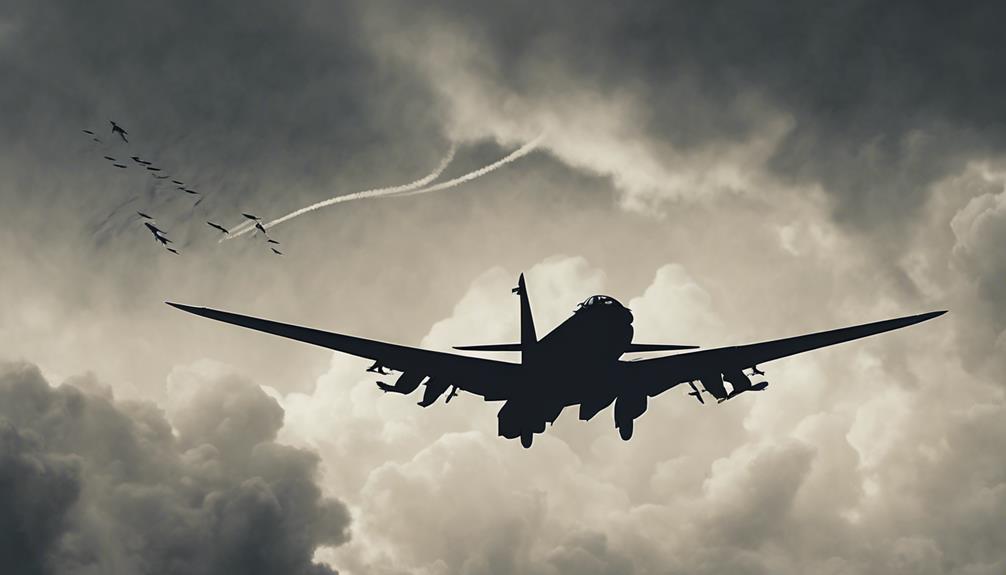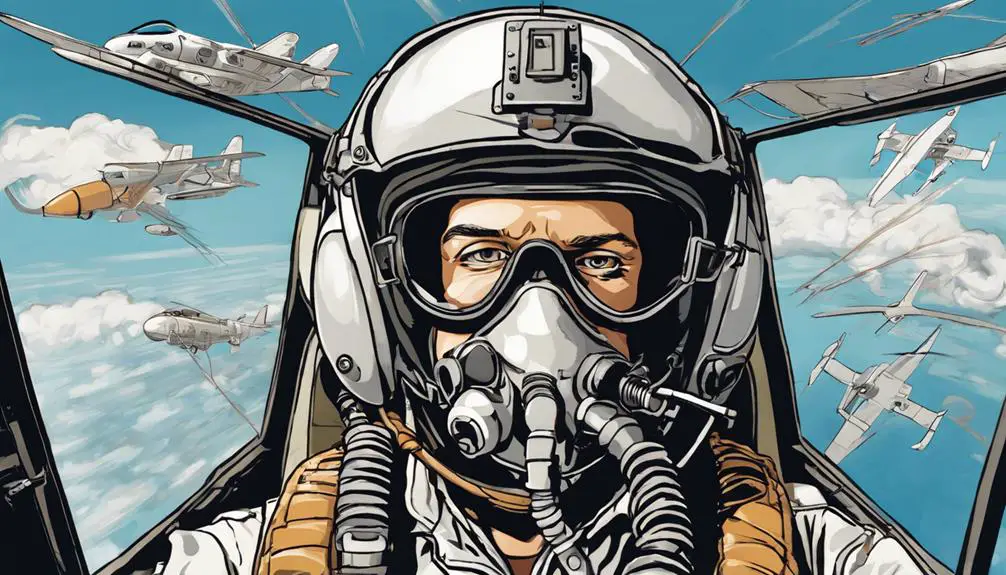You're about to uncover the secret language of the skies. In military slang, 'bird' refers to an aircraft, and understanding this lingo is vital for pilots and ground crew to communicate effectively in high-stakes situations. Derived from World War I era mechanics and engineering slang, this specialized vocabulary is designed for clarity and efficiency. From 'Bingo' to 'Bandit,' each term has a specific meaning, and using the right terminology can mean the difference between success and failure. As you explore this world, you'll discover a complex system of codified language that's both fascinating and essential for mission success.
Slang of the Skies

As you take to the skies, you'll quickly realize that pilots and aircrew rely on a unique lexicon to communicate effectively amidst the din of engines and radio chatter. This specialized language, known as Flight Jargon or Aviator Lingo, is essential for clear and concise communication during critical phases of flight.
You'll hear terms like 'roger that' (meaning 'understood') and 'squawk' (to set a specific transponder code), which may sound unfamiliar to outsiders. These colloquialisms serve a purpose, allowing pilots to convey complex information quickly and accurately. For instance, 'vector' refers to a directive from air traffic control to alter course, while 'bug out' means to depart quickly.
This distinct vocabulary isn't just a quirk; it's a crucial component of aviation safety. By using standardized terminology, pilots and aircrew can guarantee seamless communication, even in high-stress situations. As you become familiar with Flight Jargon, you'll appreciate the significance of this unique language in the world of aviation.
Origins of Aviation Lingo
Delving into the history of aviation, you'll uncover that the earliest roots of Flight Jargon can be traced back to the pioneering days of military aviation during World War I. As aviation technology rapidly evolved, so did the language used by pilots and ground crew. Early innovators, such as the Red Baron and Eddie Rickenbacker, contributed to the development of this unique dialect.
The language evolution was shaped by the need for efficient communication, brevity, and clarity in high-stress situations. You'll find that the terminology was often derived from various sources, including:
- Technical terms from mechanics and engineering
- Slang from the trenches of World War I
- Colloquialisms from the early 20th century
- Acronyms and abbreviations for quick reference
As you explore the origins of aviation lingo, you'll discover a fascinating blend of technical precision and colloquial flair. The language has continued to adapt, reflecting the dynamic nature of aviation itself.
Enemy in the Air

When you're scanning the skies for enemy aircraft, vigilance is key, and pilots rely on a specialized lexicon to swiftly convey critical information about hostile airborne threats. In the heat of battle, every second counts, and using precise terminology saves time and lives. You need to quickly identify and communicate the type, location, and movement of aerial threats to guarantee effective countermeasures.
To accomplish this, military pilots use distinct terminology to describe enemy aircraft. For instance, a 'bogey' refers to an unidentified aircraft, while a 'bandit' signifies a confirmed hostile aircraft.
You might hear 'bandit, 3 o'clock high' to alert others to an enemy plane approaching from the right and above. In hostile skies, accurate communication is essential to stay one step ahead of the enemy. By employing this unique vocabulary, pilots can swiftly respond to aerial threats, safeguarding their own safety and that of their comrades.
Radio Call Signs Decoded
In the high-stakes environment of military aviation, you rely on clear and concise communication to stay alive, and that's where radio call signs come into play, serving as an essential component of a pilot's language arsenal.
These unique identifiers are used to distinguish between aircraft, ground stations, and other communication entities. But did you know that there's more to radio call signs than just a simple label? They're often encrypted with Crypto Keys to guarantee secure transmission, and may employ Frequency Hopping techniques to minimize jamming risks.
Here are some key aspects of radio call signs:
- Authentication: Verifying the identity of the transmitting entity to prevent impersonation.
- Encryption: Using Crypto Keys to scramble messages, making them unreadable to unauthorized parties.
- Frequency Agility: Employing Frequency Hopping to rapidly switch between frequencies, evading detection.
- Call Sign Protocols: Standardized procedures for using call signs, ensuring consistency across different units and operations.
Cockpit Communication Essentials

As you depend on radio call signs to identify friendly aircraft, you also need to communicate effectively within the cockpit to guarantee a seamless exchange of information with your wingman and aircrew.
In the heat of battle, clear communication is essential to mission success. That's why understanding Pilot Hierarchy is important. You need to know who's in charge and who to report to, ensuring that critical information is relayed to the right person at the right time.
Critical Phrases are also crucial in cockpit communication. You'll use standardized phrases to convey essential information, such as 'Bogey at 2 o'clock' or 'Fox-2, Fox-2, Fox-2' to alert your wingman of an incoming threat. These phrases are designed to be concise and unambiguous, reducing confusion and ensuring a swift response.
Bird Military Slang in Action
You'll frequently hear pilots and aircrew using Bird Military Slang in high-stress situations to convey complex information quickly and accurately. This unique language is essential for effective communication in the high-pressure environment of aerial combat.
In the heat of battle, every second counts, and Bird Military Slang enables pilots to convey critical information rapidly and accurately. This specialized language, also known as Aerial Jargon or Fighter Chatter, is designed to reduce confusion and errors, ensuring seamless communication between pilots, aircrew, and ground control.
Here are some examples of Bird Military Slang in action:
- Bingo: Low fuel warning, indicating the need to refuel or return to base.
- Bandit: Enemy aircraft, used to alert fellow pilots of potential threats.
- Bogey: Unidentified aircraft, used to report unknown contacts.
- Fox Two: Short-range air-to-air missile, used to confirm weapon deployment.
Frequently Asked Questions
What Is the Most Common Bird Military Slang Term Used Today?
You're wondering what's the most common term used today.
Before we explore the world of bird military slang, let's delve into the concept of coded languages. In various industries, professionals use specialized jargon to convey complex ideas efficiently. In the domain of aviation, 'Bird Code' or 'Flight Jargon' refers to the unique terminology used by pilots and aircrew.
In modern times, one term stands out: 'Bogey.' You'll often hear pilots use 'Bogey' to identify an unidentified aircraft, emphasizing the importance of clear communication in the skies.
Can Bird Military Slang Be Used in Non-Military Aviation Contexts?
You might wonder if aviation terminology can transcend military boundaries.
In commercial aviation, pilots often adopt military-inspired lingo to enhance communication and camaraderie. While not unique to military contexts, the use of 'bird' to refer to aircraft has become an integral part of aviation culture.
Commercial pilots, in particular, have adopted this terminology, blurring the lines between military and civilian aviation language.
How Does Bird Military Slang Vary Across Different Countries?
As you venture into the world of military slang, you'll discover that regional dialects and cultural influences shape the language of the skies.
Across different countries, you'll find distinct flavors of slang, molded by local accents and customs.
In the UK, 'buster' means to hurry, while in the US, it's 'hustle.' Australia's 'fair dinkum' translates to 'genuine' or 'true.'
These nuances reflect the unique cultural fingerprints of each nation, making military slang a fascinating reflection of global diversity.
Are There Any Bird Military Slang Terms Specific to Helicopters?
You're curious about helicopter-specific slang terms. Focusing on rotor-based lingo, you'll discover unique phrases like 'Rotor Rhythms' and 'Whirly Words'.
These terms are used by helicopter crews to describe the rhythmic sounds and vibrations of the rotors. In the military, these phrases are vital for clear communication during operations.
You'll find these terms are widely used, but nuances vary across countries and units.
Can Civilians Use Bird Military Slang in Casual Conversation?
As you slide into casual conversation, you might wonder: can you borrow military slang without being a vet?
Think of it like wearing a pair of dog tags to a music festival – it's a nod to the culture, but are you really part of the pack?
Using military slang without cultural relevance raises appropriation concerns. Be mindful of the context; make sure you're not diluting the terms' original meaning.
When in doubt, opt for more neutral expressions to avoid cultural misappropriation.
Conclusion
As you step out of the cockpit, the intense focus of the skies gives way to the mundane routine of the ground. The rush of adrenaline fueled by 'Bandits' and 'Bogies' is replaced by the hum of paperwork and debriefs.
Yet, in the world of bird military slang, the thrill of the chase lives on, a secret language known only to those who've flown into the fray.







